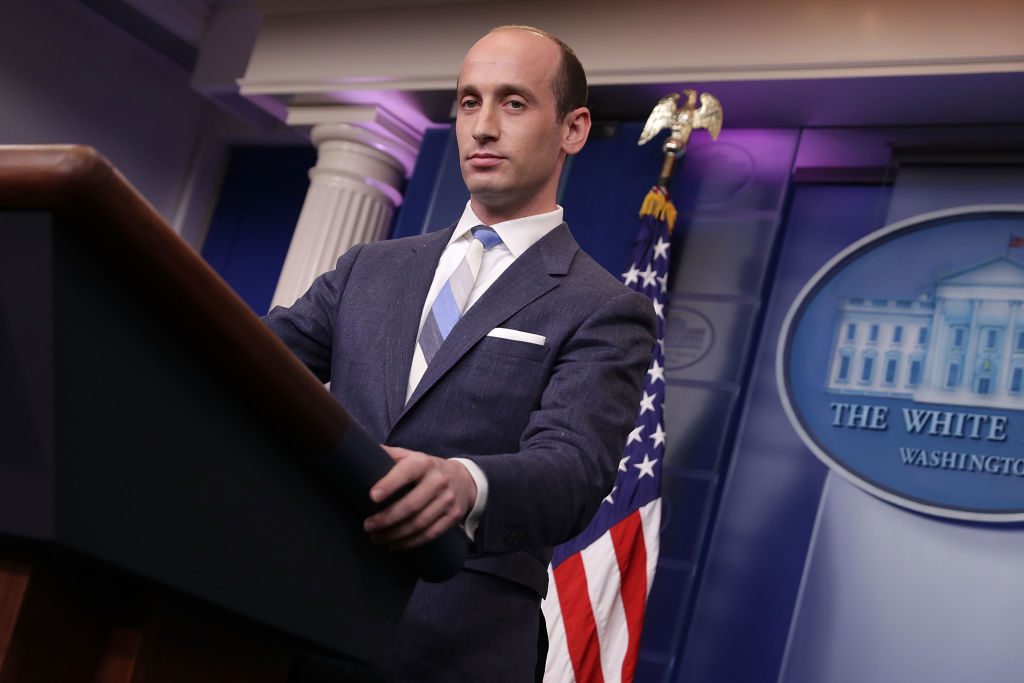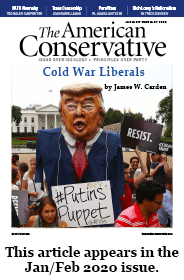Stephen Miller’s White House Fiefdom

Stephen Miller is one of the most influential and complicated figures to occupy a corner of the West Wing. The media has manufactured an image of him as a sinister white nationalist and a puppeteer inside the White House, carefully pushing policies to hurt anyone with a skin tone darker than eggshell white. Voters who have supported Donald Trump since the Republican primaries, however, think of Miller as the last best hope for the MAGA agenda.
Judging by his actions, Miller is far more nuanced than his public image as either a villain or savior. When it comes to the only two issues that matter—policy and personnel—Miller has been both an immigration hardliner advancing the president’s early agenda as well as a roadblock for ideological allies who have applied for jobs inside the administration.
When it comes to policy, Miller is a fairly consistent voice for restricting immigration, yet what many have described as his desire to undercut fellow immigration hawks has limited his success. By not fighting to fill the administration and the bureaucracy with likeminded allies, Miller has allowed career officials to only casually enforce the executive orders and rules changes he has fought to implement. Some of those accomplishments include the travel ban, refugee reduction, and the public charge rule.
Implementing that agenda hasn’t been smooth sailing, in part because of Miller’s desire to go it alone. The travel ban, known by mainstream media outlets as the “Muslim ban,” was issued very quickly after Trump was sworn into the presidency. Miller’s insistence on haphazardly rushing through the executive order and keeping out key administration officials caused it to be executed terribly. The result was disastrous, protests broke out at airports across the country, and various agencies were left scrambling to deal. Ultimately the executive order was forced to undergo two revisions but was ultimately held up by the Supreme Court in Trump v. Hawaii.
Miller has spent much of the last three years focused on these types of executive orders and rules changes, trying to ensure that they make it through the bureaucratic maze. It was Miller who ordered that several departments prioritize the public charge, a rule change that bars immigrants from obtaining green cards if they used one or more public benefits for more than 12 months out of a period of three years. These executive orders and rule changes have been one of the few areas where Trump can say to his base that he is trying to keep his promises on immigration, and Miller deserves much of that credit.
While he has been successful at pushing forward executive orders and rule changes, the signature legislative policy he planned on championing in Trump’s first term stalled out of the gate. His plan to offer Dreamers—a subset of illegal immigrants who arrived in the United States as minors—amnesty in exchange for a reduction to legal immigration and a border wall won little fanfare among conservatives or liberals. Most famously, Breitbart editor Matt Boyle had a combative conversation with Miller in his office in late 2017 over the proposal, according to various media outlets. The plan was viewed as a betrayal to Trump’s base, while never earning enough support from more immigration-dovish Republican senators like Lindsey Graham and Jeff Flake.
Miller’s claim to a major legislative victory wasn’t in what he got Congress to pass, but what bills he has managed to kill. This includes a bipartisan DACA compromise authored by Senators Graham and Dick Durbin. According to a report from Business Insider, Miller invited congressional Republicans who are immigration hawks into the meeting where Graham and Durbin were going to sell their immigration policy to the president, successfully sabotaging their plan.
These fights over amnesty and executive orders regarding immigration have helped create the media narrative that it’s him against the entire D.C. establishment. Being the big bad immigration hawk in the White House is an image Miller has helped cultivate with the press, working them with the help of several White House allies.
Yet it hasn’t been lost on some prominent Trump supporters that Miller is one of very few immigration hawks in a senior White House job. Personnel has been an area of continued frustration for Trump and his supporters. Part of the reason Miller is an immigration outlier in the Trump Administration is by his own design.
Nationally syndicated conservative columnist Ann Coulter said during an interview with PBS’s Frontline, “(Miller) is very smart, but he’s never taken to heart the important Reagan slogan, there’s no end to what can be accomplished if you don’t care who gets the credit.”
♦♦♦
From the time Miller walked into the White House, he began isolating fellow immigration hawks both in and outside of the administration. He acted as a gatekeeper to the president, and many fellow restrictionists found themselves without a channel to address their concerns. Those who managed to get jobs inside the administration were slowly picked off by former Republican National Committee and Bush officials who received prominent positions thanks to former personnel director Johnny DeStefano.
Even those who campaigned for Trump and had long relationships with Miller were left out in the cold. Several prominent immigration hardliners who spoke on condition of anonymity stated how their contact with Miller over the last three years has been sparse to non-existent. The White House did not respond to a request for comment.
Aside from isolating immigration hardliners, Miller has gone out of his way to block some ideological allies who’ve applied for jobs inside the White House.
Former Kansas secretary of state Kris Kobach was a repeated target. When the administration began forming, Trump offered the position of DHS Secretary to Kobach, the only statewide elected official from Kansas to endorse Trump in 2016 and arguably the most well-known immigration hawk in the country. The offer was quickly rescinded after several advisers, including then White House chief of staff Reince Priebus told Trump that Kobach would have a difficult time obtaining Senate confirmation.
Whether that was true was a debatable point, but few near the president pressured him to take on the fight to confirm Kobach. Miller not only did nothing to pressure Trump to bring along Kobach, but he also called well-known conservative pundits and said Kobach wasn’t hired because he was challenging to work with and a “prima donna.”
In 2019, Kobach was again being considered for a White House position, this time as immigration czar, a position that had a lofty title but little authority. During a meeting with Miller, Trump, and acting chief of staff Mick Mulvaney, Kobach presented a list of demands for the position including staff, the role of administration spokesperson on immigration, the use of a jet, and the eventual nomination as DHS secretary. Within a week of presenting the list, Miller’s allies leaked it to The New York Times, publicly embarrassing Kobach. Trump ended up picking Miller’s personal choice of Ken Cuccinelli for the position. Ultimately, Cuccinelli would never take the job but instead filled the role of acting USCIS director after former head Lee Francis Cissna was forced out with Miller’s help.
Like Kobach, Cissna was well respected among immigration restrictionist groups but found himself on Miller’s enemies list. The cause of the rift appears to be an administration phone call where Cissna told Miller to stop berating staffers. Cissna became Miller’s main target after this phone conversation, though some White House officials stated the call was just the last in a series of events where Cissna questioned Miller in front of other people, an act the senior Trump adviser doesn’t tolerate. In the months following this phone call, Miller and his allies described Cissna to media outlets as an opponent to Trump’s immigration agenda. When I reported that the Angel Moms were seeking a meeting with Trump over wall funding and were being kept from meeting with the president, Miller’s allies in the administration called conservative writers and editors insisting that Cissna was responsible.
White House speechwriter Darren Beattie was another early Trump supporter who found himself on Miller’s wrong side when CNN reported that Beattie spoke at an event also attended by Peter Brimelow. Even though Beattie was not speaking on a subject like race or even immigration, and had public defenders like Tucker Carlson and Ann Coulter, he was still fired.
Yet Miller has advocated on behalf of personnel whose records on immigration are very different than his own. After Kirstjen Nielsen left the position of DHS secretary, Miller campaigned for Kevin McAleenan to replace her. Staffers warned Miller that McAleenan had a reputation of opposing both President Trump and his immigration promises. By the time Nielsen left, DHS, like many other departments, was crawling with staffers who openly despised the president and his policies.
Miller shrugged off any concerns about McAleenan and insisted he had “a good working relationship with him.” During McAleenan’s short time as acting DHS secretary, he leaked ICE raids to The Washington Post and asked White House lawyers to raise concerns about Trump’s “Remain in Mexico” policy for asylum-seekers.
After McAleenan’s stint ended in October 2019, Miller pushed for cheap labor lobbyist and Nielsen’s former chief of staff Chad Wolf to replace him. This was such a heavy lift that Miller personally reached out to skeptics who preferred Cuccinelli.
Miller remains the public face of the Trump immigration agenda. But in Washington, it is often said that personnel is policy. On that front, his impact has been much more mixed.
Ryan Girdusky is a writer based out of New York City. Read more of his work at RyanGirdusky.com.
Comments